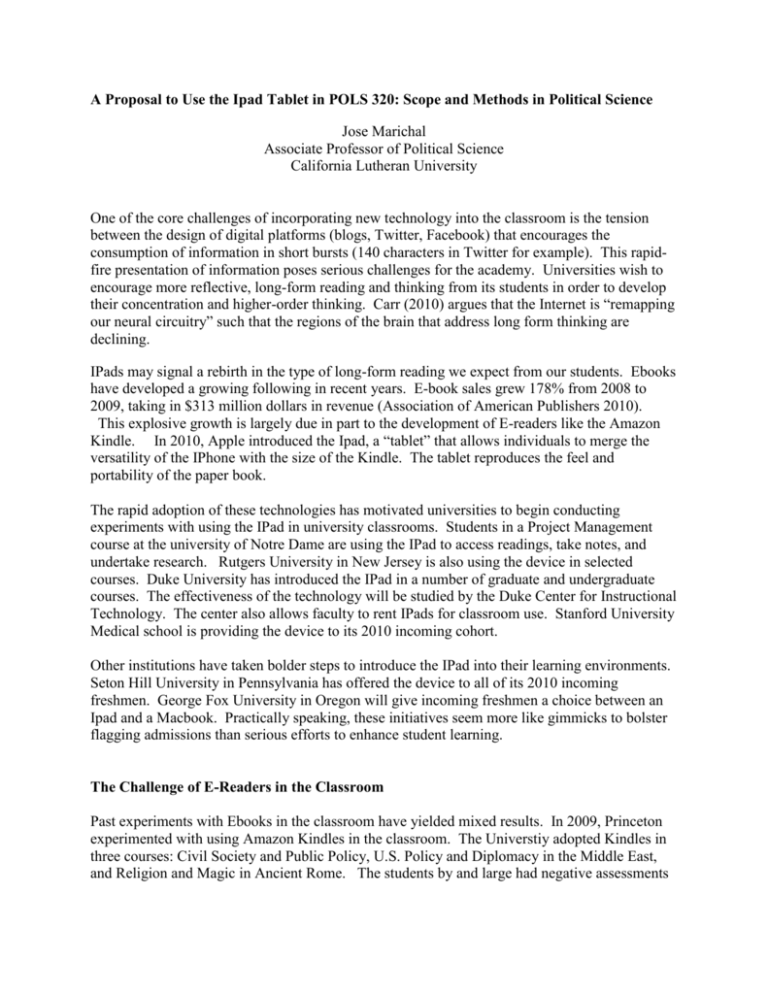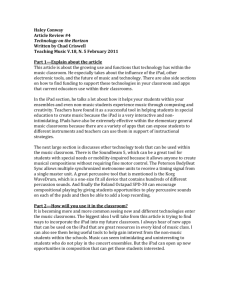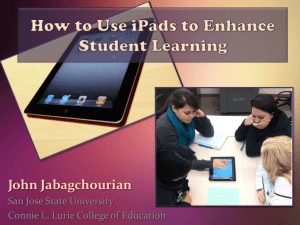Poly Sci 320 - California Lutheran University
advertisement

A Proposal to Use the Ipad Tablet in POLS 320: Scope and Methods in Political Science Jose Marichal Associate Professor of Political Science California Lutheran University One of the core challenges of incorporating new technology into the classroom is the tension between the design of digital platforms (blogs, Twitter, Facebook) that encourages the consumption of information in short bursts (140 characters in Twitter for example). This rapidfire presentation of information poses serious challenges for the academy. Universities wish to encourage more reflective, long-form reading and thinking from its students in order to develop their concentration and higher-order thinking. Carr (2010) argues that the Internet is “remapping our neural circuitry” such that the regions of the brain that address long form thinking are declining. IPads may signal a rebirth in the type of long-form reading we expect from our students. Ebooks have developed a growing following in recent years. E-book sales grew 178% from 2008 to 2009, taking in $313 million dollars in revenue (Association of American Publishers 2010). This explosive growth is largely due in part to the development of E-readers like the Amazon Kindle. In 2010, Apple introduced the Ipad, a “tablet” that allows individuals to merge the versatility of the IPhone with the size of the Kindle. The tablet reproduces the feel and portability of the paper book. The rapid adoption of these technologies has motivated universities to begin conducting experiments with using the IPad in university classrooms. Students in a Project Management course at the university of Notre Dame are using the IPad to access readings, take notes, and undertake research. Rutgers University in New Jersey is also using the device in selected courses. Duke University has introduced the IPad in a number of graduate and undergraduate courses. The effectiveness of the technology will be studied by the Duke Center for Instructional Technology. The center also allows faculty to rent IPads for classroom use. Stanford University Medical school is providing the device to its 2010 incoming cohort. Other institutions have taken bolder steps to introduce the IPad into their learning environments. Seton Hill University in Pennsylvania has offered the device to all of its 2010 incoming freshmen. George Fox University in Oregon will give incoming freshmen a choice between an Ipad and a Macbook. Practically speaking, these initiatives seem more like gimmicks to bolster flagging admissions than serious efforts to enhance student learning. The Challenge of E-Readers in the Classroom Past experiments with Ebooks in the classroom have yielded mixed results. In 2009, Princeton experimented with using Amazon Kindles in the classroom. The Universtiy adopted Kindles in three courses: Civil Society and Public Policy, U.S. Policy and Diplomacy in the Middle East, and Religion and Magic in Ancient Rome. The students by and large had negative assessments of the Kindle. The frustration with the technology’s limitations is well summarized by a student’s reflection on how the Kindle forced him to rethink his approach to learning material: “Much of my learning comes from a physical interaction with the text: bookmarks, highlights, page-tearing, sticky notes and other marks representing the importance of certain passages — not to mention margin notes, where most of my paper ideas come from and interaction with the material occurs,” he explained. “All these things have been lost, and if not lost they’re too slow to keep up with my thinking, and the ‘features’ have been rendered useless” (Lee 2009, online) The IPad has some features that might set it apart from the Kindle and thus make it a more useful classroom tool. One is that the Ipad uses the touch technology as its primary interface, much like the IPhone. This allows users to use their fingers to “turn the page,” unlike the Kindle where readers are required to press a button. While a seemingly small thing, this allows the IPad to feel more like a paper book. The Nielsen Norman group found that, while people read more slowly on Ebook devices than through paper, they preferred the Ipad to paper text. Users were reading 6.2 percent slower on an iPad compared to paper, and 10.7 percent slower on the Kindle.... The test subjects said that reading on the PC felt too much like being at work, while they found it (reading on an IPad) more relaxing to read a printed book on an electronic device.(Paul 2010). Second, because it isn’t a e-book per se, the Ipad provides users with a full range of support applications that can enhance the reading experience. As of August 2010, there were 100,000 “apps” for the Ipad, with hundreds of new applications being developed daily. These apps merge the benefits of the Web with the portability of a paper book. For instance, Inkling is developing an app to supplement textbook reading by allowing students to collaboratively annotate readings. Students and the professor can leave “messages” on the text for others to read making it a more collaborative experience. Third Apple’s policy towards app development makes it an appropriate technology for learning institutions. The company forbids developers from making applications that “… that in Apple's reasonable judgment may be found objectionable [eg] materials that may be considered obscene, pornographic or defamatory." This control over app development makes it harder for students to use the technology to access prurient materials not connected to academic learning. Finally, using the Ipad to deliver content reaches students where they live. Increasingly, our students are accessing web technology through portable devices. In 2009, 96 percent of Americans aged 18 to 29 “own a cellphone of some kind (Smith 2010, NYT). Increasingly young people are moving towards tabled devices like the IPad. Apple (2010) claims they are selling close to five million IPad’s each quarter. Gartner Research (2010) predicts Apple will sell close to 20 million IPads by the end of 2010. Bernstien Research (2010) claims that the Ipad has enjoyed the fastest adoption rate of any technological device since the DVD player in 1994. This adoption rate has been so great among young people that a number of university have been forced to ban them on their campuses. Princeton University, Cornell University and George Washington University have been forced to ban IPads in large part because the tablets have caused server overloads (Whittaker 2010). Proposal I propose using my research methods course POLS 320 (Scope and Methods in Political Science) to pilot the use of IPads in academic courses. The methods class requires students to engage in active data collection. As such, I would create an semester-long project that required students to conduct surveys and “field work” on a specific topic. This field work would allow students to leverage the portability of the IPad by allowing them to take in-field notes and to conduct in-field survey in efficient ways that can also be shared with the rest of the class. This approach is being used at Duke University in a Master’s level health sciences methods course where students use the tablets to conduct field research and quantitative surveys. In addition, the tablets could allow for greater self-analysis and reflection. One particular assignment that I’d employ is a personal data collection project. Improvements in data storage allow allows individuals to collect vast amounts of data. I propose to introduce a self-analysis assignment where students are required to collect self-selected data upon themselves and conduct their own scientific study on their own behavior. The data can be then used to learn basic concepts in scientific analysis. This is in keeping with the university’s mission of selfdevelopment. For example a student can use the device to track their television viewing habits and can study the relationship between their TV habits and the amount of studying they do in a day. If the student is so inclined, they could use biometric devices to track all sorts of information about themselves (heart rate, sleep tracking data, etc.). This proposal asks the universities to purchased 26 devices to be used for the Fall 2011 semester methods course. One device would be loaned to the instructor and would be purchased in the spring of 2011 to give him/her time to learn the capabilities of the technology. The other 25 units would be loaned to the students for the fall 2011 semester. The instructor would evaluate the use of the technology and prepare a report to the university and present the findings to the faculty and the cabinet. The results of this pilot study can be used to determine if the institution seeks to go further in adopting the technology for broader use throughout the university. Cost 26 IPads X $400 = $10,400





